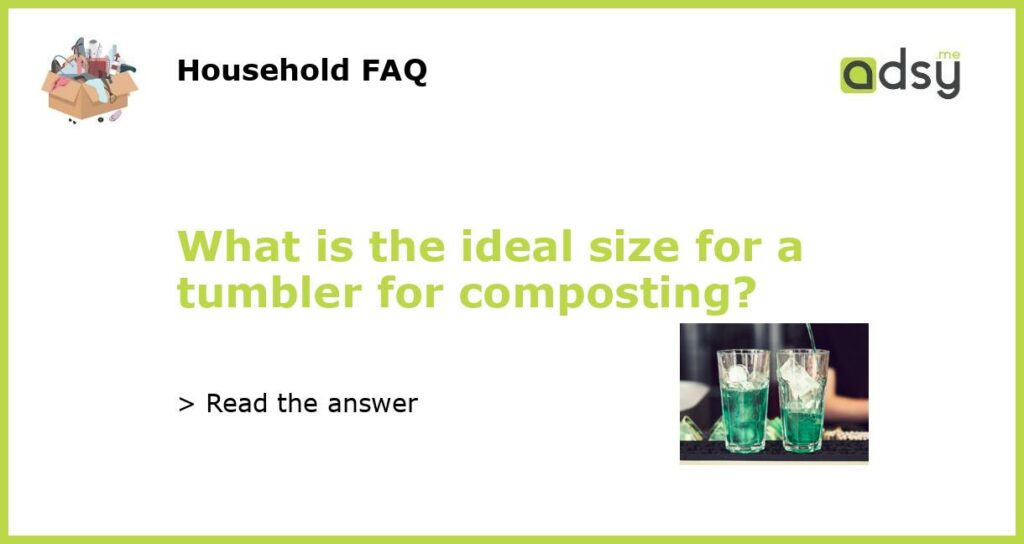Understanding the Ideal Size for a Tumbler for Composting
Composting is an efficient and sustainable way to manage organic waste and create nutrient-rich soil for gardening. One popular method of composting is using a tumbler, which helps speed up the decomposition process and makes it easier to turn and aerate the compost. However, many people wonder what the ideal size is for a tumbler for composting. In this article, we will dive into the factors that determine the ideal size and provide some helpful tips for choosing the right tumbler for your composting needs.
Factors to Consider When Determining the Ideal Size
When selecting a tumbler for composting, there are several factors to consider that will help determine the ideal size for your needs. These factors include your available space, the amount and type of waste you generate, and your overall composting goals.
Available Space
The first consideration when determining the ideal size for a composting tumbler is the available space. Tumblers come in a range of sizes, from compact options suitable for small gardens or balconies to larger models that can handle more waste. Measure the area where you plan to place the tumbler and consider any space restrictions you may have. Additionally, ensure that there is enough room around the tumbler for easy access and turning.
Amount and Type of Waste
The amount and type of waste you generate is another important factor in determining the ideal size for a tumbler. If you have a large household or generate a significant amount of organic waste, you may need a larger tumbler to accommodate the volume. Additionally, consider the types of waste you will be composting. Some materials, such as kitchen scraps or yard trimmings, require more space and airflow to decompose effectively.
Composting Goals
Your composting goals will also play a role in determining the ideal size for a tumbler. If your primary goal is to compost for personal use and provide nutrient-rich soil for your garden, a smaller tumbler may be sufficient. However, if you plan to compost on a larger scale or produce compost for sale or distribution, a larger tumbler may be necessary to handle the increased volume.
Tips for Choosing the Right Tumbler Size
Now that you understand the factors to consider when determining the ideal size for a composting tumbler, here are some tips to help you choose the right size for your needs.
Start Small
If you are new to composting or have limited space, it is advisable to start with a smaller tumbler. A compact tumbler can still efficiently process organic waste and provide you with high-quality compost for your gardening needs. Starting small also allows you to gauge your composting habits and adjust accordingly in the future.
Consider Future Growth
If you anticipate that your composting needs may grow in the future, it is wise to choose a tumbler that can accommodate that growth. Selecting a slightly larger size will save you from needing to upgrade later on. However, be mindful not to choose a size that is too large for your current needs, as an underfilled tumbler can lead to slower decomposition and inadequate airflow.
Look for Adjustable Models
Some tumblers come with adjustable capacity options, allowing you to expand or reduce the size as needed. These models are particularly useful if you have varying composting needs throughout the year or if you anticipate changes in your household size.
Consider Maintenance and Ease of Use
When selecting a tumbler, also consider the maintenance and ease of use. Larger tumblers may require more effort to turn, especially when filled to capacity. If you have physical limitations or prefer a more effortless composting experience, opt for a smaller tumbler that suits your needs. Additionally, look for tumblers with convenient features such as easy access doors and efficient ventilation systems.
Read Reviews and Seek Recommendations
Before making a final decision, read reviews and seek recommendations from other composters or gardening enthusiasts. Hearing about other people’s experiences with specific tumbler sizes and brands can provide valuable insights and help you make an informed decision.
In conclusion, the ideal size for a tumbler for composting depends on several factors, including available space, the amount and type of waste, and your composting goals. By considering these factors and following the tips provided, you can choose the right tumbler size to meet your composting needs effectively.






